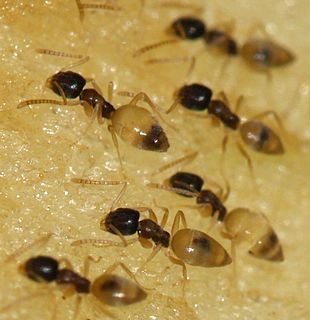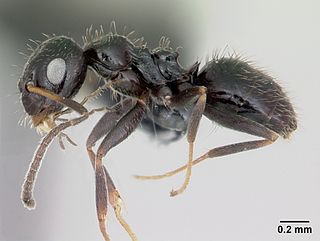
Ponerinae is a subfamily of ants in the Poneromorph subfamilies group, with about 1,600 species in 47 extant genera, including Dinoponera gigantea - one of the world's largest species of ant. Mated workers have replaced the queen as the functional egg-layers in several species of ponerine ants. In such queenless species, the reproductive status of workers can only be determined through ovarian dissections. Ponerinae is a subfamily of ants within the family of Formicidae. These ants typically nest in soil, forest litter, or rotting logs, and are predacious. They primarily prey on isopods. They mostly live in small colonies of up to 200 workers. They can be found mostly in tropical environments, but have been found in southeastern Canada and New York. Female workers have twelve segmented antennae, whereas male workers have 13 segmented antennae.

Myrmicinae is a subfamily of ants, with about 140 extant genera; their distribution is cosmopolitan. The pupae lack cocoons. Some species retain a functional sting. The petioles of Myrmicinae consist of two nodes. The nests are permanent and in soil, rotting wood, under stones, or in trees.

Tapinoma is a genus of ants that belongs to the subfamily Dolichoderinae. The genus currently comprises 74 described species distributed worldwide in tropical and temperate regions. Members of are generalized foragers, nesting in a wide variety of habitats, ranging from grasslands, open fields, woodlands, to inside buildings. The majority of species nest in the ground under objects such as stones or tree logs, other species build nests under bark of logs and stumps, in plant cavities, insect galls or refuse piles.

Anonychomyrma is a genus of ants in the subfamily Dolichoderinae.

Crematogaster is an ecologically diverse genus of ants found worldwide, which are characterised by a distinctive heart-shaped gaster (abdomen), which gives them one of their common names, the Saint Valentine ant. Members of this genus are also known as cocktail ants because of their habit of raising their abdomens when alarmed. Most species are arboreal. These ants are sometimes known as acrobat ants.

Pseudomyrmex is a genus of stinging, wasp-like ants in the subfamily Pseudomyrmecinae. They are large-eyed, slender ants, found mainly in tropical and subtropical regions of the New World.

Tetramorium is a genus of ants in the subfamily Myrmicinae that includes more than 520 species.

Aenictus is a large army ant genus distributed in the Old World tropics and subtropics. It contains about 181 species, making it one of the larger ant genera of the world.

Diacamma is a genus of queenless ants sometimes known as Asian bullet ants, belonging to the subfamily Ponerinae. It is distributed from India to Australia and contains about 24 species.

Anochetus is a genus of small, carnivorous ants found in the tropics and subtropics throughout the world.

Tetraponera is a genus of ants in the subfamily Pseudomyrmecinae that are commonly known as slender ants and are characterized by their arboreal nature and slender bodies. The 86 described species of Tetraponera all live in hollow structures of plants and trees, such as thorns or branches; these hosts are known as myrmecophytes. Tetraponera species are closely related to the New World genus of ants Pseudomyrmex, but differ in their relationships with host plants.

Hypoponera is a genus of ants in the subfamily Ponerinae. The genus has a worldwide distribution and is found in all continents except Antarctica.

Cerapachys is a genus of ants in the subfamily Dorylinae. Species are mainly myrmecophagous ants which raid the nests of other ants for prey. The genus is distributed widely throughout the tropical and subtropical regions of the world, with the majority of species known from the Indo-Australian region.

Cataulacus is a genus of ants in the subfamily Myrmicinae. The genus is distributed in the Paleotropical regions, mainly in the Afrotropics. Most species are found in forests, but a few are known from more open and arid habitats.

Vollenhovia is a genus of ants in the subfamily Myrmicinae.

Carebara is a genus of ants in the subfamily Myrmicinae. It is one of the largest myrmicine genera with more than 174 species distributed worldwide in the tropics and the Afrotropical region. Many of them are very tiny cryptic soil and leaf litter inhabitants. They nest in rotten wood to which the bark is still adherent in the Afrotropical region, or may be lestobiotic nesting near other ant species. Some species are known to exist parasitically within termite nests. Little is known about the biology of the species. However, they are notable for the vast difference in size between queens and workers.

Lepisiota is an Old World genus of ants in the subfamily Formicinae. They nest in rotten wood, in standing trees or in the ground, generally in less forested areas.
Camponotus irritans is a species of carpenter ant. It is found in many Asian and Oceanian countries.

















